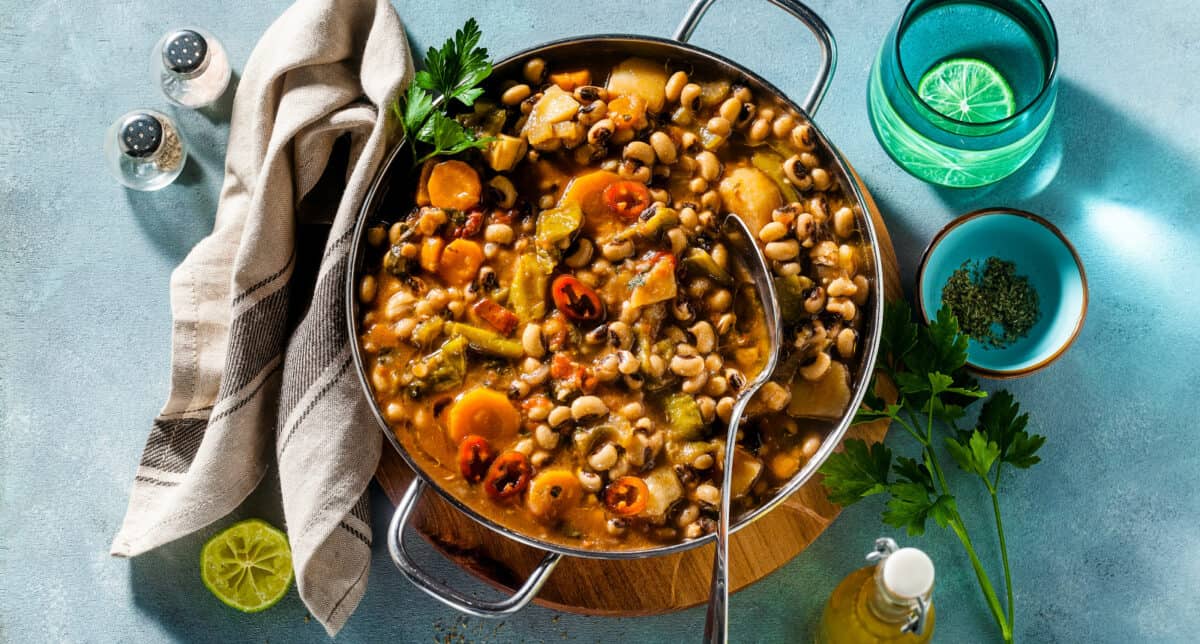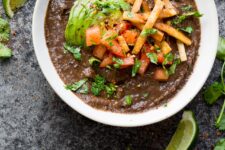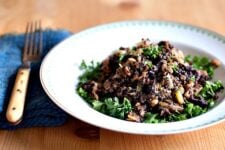Unless you live in the South, you might not eat black-eyed peas all that often. In fact, you might not eat them at all, or know that much about them.

Black-eyed peas have a strong connection with Southern culture and traditions, particularly when it comes to New Year’s Eve and Day. And despite their name, they’re not actually peas. Here’s what you need to know.
What are Black-Eyed Peas?
That’s right; black-eyed peas aren’t actually peas. Technically, a black-eyed pea is a bean, which is a little more evident once you take a gander at the peas’ bean-like shape, as well as once you cook and taste them.
According to the Library of Congress, whereas black-eyed peas today are more associated with southern cuisine, this legume has a long and international history. Black-eyed peas were enjoyed in pre-historic China and India, and preferred by Greeks and Romans. Enslaved Africans brought the crop to the New World, where black-eyed peas became an important food source.
How are Black-Eyed Peas Connected to New Year’s Day?
A common New Year’s meal in the South is a combination of black-eyed peas and collard greens. Superstition states that eating this meal will bring you fortune and good luck in the year ahead, as the peas represent coins and the greens represent green money.
If you throw in some cornbread, the side dish will bring additional luck, as the cornbread represents gold. Not so worried about your fortunes in the new year, and would prefer to eat something to guarantee good health in the year ahead? Just add stewed tomatoes to the mix. If you really want to up your luck, you’ll be sure to eat exactly 365 black-eyed peas.
This tradition is rumored to date back to the Civil War, when black-eyed peas were an even more important food source, as one of the few crops that were leftover in the South after Union war troops moved through the region. The black-eyed peas were considered lucky, and the myth and lore grew around this delicious food.
How to Cook Black-Eyed Peas for New Year’s Day
As for how you cook your black-eyed peas for New Year’s Day (or for any other occasion), you have options.
If you buy dried black-eyed peas, you can cook them just like you would any other dried bean, by rinsing, boiling, then simmering the peas until tender and done. If you purchase canned black-eyed peas, prep is as easy as heating the peas and seasoning as you wish. Salt, pepper, garlic, onions, bacon grease, and broth are all possible additions, to give the peas more flavor.
If you want to stick with a classic, try the recipe below for Black-Eyed Pea Soup, adapted from this popular recipe.
Black-Eyed Pea Soup
Ingredients
- 1 lb black-eyed peas dry
- 2 tbsp olive oil
- 1 white onion large
- 4 cloves garlic minced
- 4 cups chicken broth
- 4 cups water
- 1 lb ham hocks
- 14.5 oz tomatoes one can, diced
- 2 carrots sliced
- 4-6 pepperoncini peppers
- 1 bay leaf
- 1/4 thyme ground
- salt & pepper to taste
Instructions
- Begin by soaking the black-eyed peas. Place them in a large bowl and cover with water, ensuring the water level is about an inch above the peas. Leave them to soak at room temperature for 8 hours or overnight. After soaking, drain the water, give the peas a good rinse, and set them aside.
- In a large stockpot, warm the olive oil over medium heat. Toss in the chopped onion and garlic, sautéing until the onion is clear and tender, which should take around 5 minutes. Next, add the broth and water to the pot, bringing the mixture to a boil before lowering the heat to maintain a gentle simmer. Now, blend in the soaked black-eyed peas, ham hocks, tomatoes along with their juice, carrots, pepperoncini, a bay leaf, garlic powder, thyme, and season with salt and pepper to taste.
- Place a lid on the pot and let it simmer for about about 3 to 4 hours. The soup is ready when the peas become soft, the meat from the ham hocks easily falls off the bone, and the broth achieves the desired consistency.







